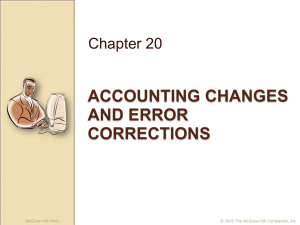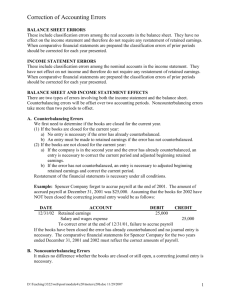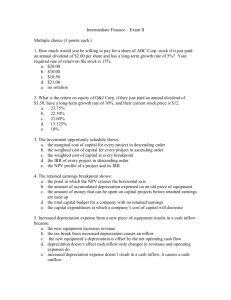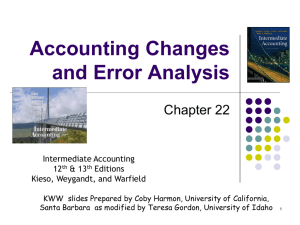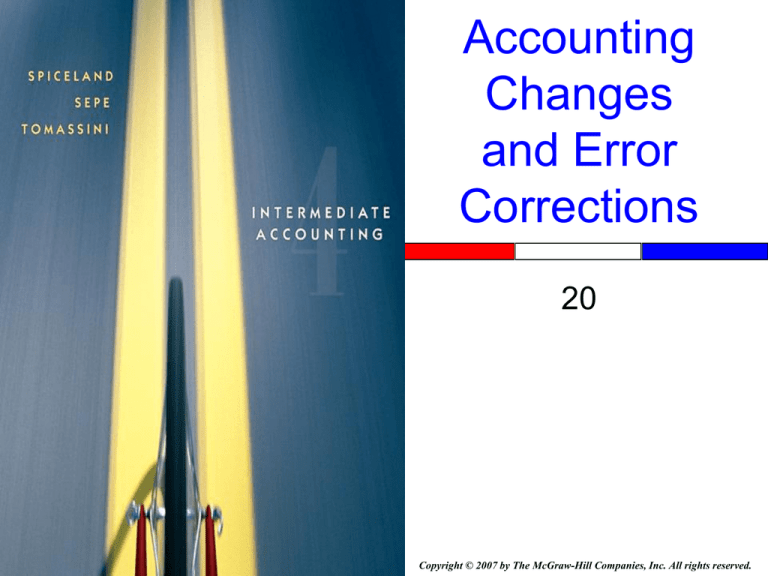
Accounting
Changes
and Error
Corrections
Insert Book Cover
Picture
20
Copyright © 2007 by The McGraw-Hill Companies, Inc. All rights reserved.
20-2
Learning Objectives
Differentiate between the three types of
accounting changes and between the
retrospective and prospective approaches to
accounting for and reporting accounting
changes.
20-3
Accounting Changes
Type of Accounting
Change
Change in Accounting
Principle
Change in Accounting
Estimate
Change in Reporting
Entity
Definition
Replaces one GAAP with
another GAAP
Revision of an estimate
because of new
information or new
experience
Change from reporting as
one type of entity to
another type of entity
20-4
Accounting Changes
Error corrections are . . .
Transactions that are either
recorded incorrectly or not
recorded at all.
Not actually accounting changes,
but are accounted for similarly.
20-5
Accounting Changes and
Error Corrections
Retrospective
Two
Reporting
Approaches
Prospective
20-6
Accounting Changes and
Error Corrections
Retrospective
Revise prior year’s statements that are
Two
presented
for comparative purposes to reflect
the Reporting
impact of the change.
The
balance in each account affected is revised to
Approaches
appear as if the newly adopted accounted method
had been applied all along or that the error had
never occurred.
Prospective
Adjust the beginning balance of retained earnings
for the earliest period reported.
20-7
Accounting Changes and
Error Corrections
The change is implemented in the
current
Retrospective
period and its effects are reflected in the
financial statements of the current and
futureTwo
years only.
Prior years’ statements are not revised.
Reporting
Account balances are not revised.
Approaches
Prospective
20-8
Learning Objectives
Describe how changes in accounting principle
typically are reported.
20-9
Change in Accounting Principle
Qualitative
Characteristics
Consistency
Comparability
Although consistency and comparability are desirable,
changing to a new method is sometimes appropriate.
20-10
Motivation for Accounting Choices
Effect on
Compensation
Changing
Conditions
Motivations
for Change
Effect on Debt
Agreements
New Standard
Issued
Effect on Union
Negotiations
Effect on
Income Taxes
20-11
Retrospective Approach
Let’s look at an examples of a change from LIFO to
FIFO that is reported using the retrospective approach.
At the beginning of 2006, Air Parts Corporation changed
from LIFO to FIFO. Air Parts has paid dividends of $40 million
each year since 1999. Its income tax rate is 40 percent.
Retained earnings on January 1, 2004, was $700 million;
inventory was $500 million. Selected income statement
amounts for 2006 and prior years are (in millions):
Cost of goods sold (LIFO)
Cost of goods sold (FIFO)
Difference
Revenues
Operating expenses
Previous
2006
2005
2004
Years
$
430 $
420 $
405 $
2,000
370
365
360
1,700
$
60 $
55 $
45 $
300
$
950 $
230
900 $
210
875 $
205
4,500
1,000
20-12
Retrospective Approach
For each year reported, Air Parts makes the comparative
statements appear as if the newly adopted accounting
method (FIFO) had been in use all along.
Income Statements (Millions)
Revenues
Less: Cost of goods sold (FIFO)
Operating expenses
Income before tax
Less: Income tax expense (40%)
Net income
2006
2005
2004
$
950 $
900 $
875
370
365
360
230
210
205
$
350 $
325 $
310
140
130
124
$
210 $
195 $
186
20-13
Retrospective Approach
For each year reported, Air Parts makes the comparative
statements appear as if the newly adopted accounting
method (FIFO) had been in use all along.
Cost of goods sold (LIFO)
Cost of goods sold (FIFO)
Difference
Previous
2006
2005
2004
Years
$
430 $
420 $
405 $
2,000
370
365
360
1,700
$
60 $
55 $
45 $
300
Comparative balance sheets will report 2004 inventory $345
million higher than it was reported in last year’s statements.
Retained earnings for 2004 will be $207 million higher.
[$345 million × (1 – 40% tax rate)]
20-14
Retrospective Approach
For each year reported, Air Parts makes the comparative
statements appear as if the newly adopted accounting
method (FIFO) had been in use all along.
Cost of goods sold (LIFO)
Cost of goods sold (FIFO)
Difference
Previous
2006
2005
2004
Years
$
430 $
420 $
405 $
2,000
370
365
360
1,700
$
60 $
55 $
45 $
300
Comparative balance sheets will report 2005 inventory $400
million higher than it was reported in last year’s statements.
Retained earnings for 2005 will be $240 million higher.
[$400 million × (1 – 40% tax rate)]
20-15
Retrospective Approach
For each year reported, Air Parts makes the comparative
statements appear as if the newly adopted accounting
method (FIFO) had been in use all along.
Cost of goods sold (LIFO)
Cost of goods sold (FIFO)
Difference
Previous
2006
2005
2004
Years
$
430 $
420 $
405 $
2,000
370
365
360
1,700
$
60 $
55 $
45 $
300
Comparative balance sheets will report 2006
inventory $460 million higher than it would have
been if the change from LIFO had not occurred.
Retained earnings for 2006 will be $276 million higher.
[$460 million × (1 – 40% tax rate)]
20-16
Retrospective Approach
On January 1, 2006, the date of the change,
the following journal entry would be made
to record the change in principle:
GENERAL JOURNAL
Date
Description
Inventory
PR
Debit
Page 4
Credit
400,000,000
Retained Earnings
240,000,000
Deferred Tax Liability
160,000,000
40% of $400,000,000
20-17
Retrospective Approach
In the first set of financial statements after the
change is made a disclosure note is needed to:
Provide
justification
for the change.
Point out that
comparative
information has
been revised.
Report any per
share amounts
affected for the
current and all
prior periods.
20-18
Learning Objectives
Explain how and why some changes in
accounting principle are reported
prospectively.
Explain how and why changes in estimates are
treated prospectively.
20-19
Prospective Approach
The prospective approach is used when it is:
Impracticable to determine some periodspecific effects.
Impracticable to determine the cumulative
effect of prior years.
Mandated by authoritative pronouncements.
FASB
Statement
Update
20-20
Prospective Approach
A change in depreciation method
is considered to be a change in
accounting estimate that is
achieved by a change in
accounting principle. It is
accounted for prospectively as
a change in accounting
estimate.
20-21
Changing Depreciation Methods
Universal Semiconductors switched from SYD
depreciation to straight-line depreciation in 2006.
The asset was purchased at the beginning of 2004
for $63 million, has a useful life of 5 years and
an estimated residual value of $3 million.
Sum-of-the-Years-Digits Depreciaton (millions)
2004 depreciation
2005 depreciation
Accumulated depreciation
$ 20
16
$ 36
($60 x 5/15)
($60 x 4/15)
20-22
Changing Depreciation Methods
÷
20-23
Changing Depreciation Methods
Depreciation adjusting entry
for 2006, 2007, and 2008.
GENERAL JOURNAL
Date
Description
Depreciation Expense
Accumulated Depreciation
PR
Debit
Page 4
Credit
8,000,000
8,000,000
20-24
Changing an Estimate
Changes in accounting
estimates are also accounted
for prospectively.
Let’s look at an example
of a change in a
depreciation estimate.
20-25
Changing an Estimate
On January 1, 2002, Towing, Inc. purchased
specialized equipment for $243,000. The
equipment was depreciated using straight-line
and had an estimated life of 10 years and
salvage value of $3,000. In 2006 the total
useful life of the equipment was revised to 6
years. The 2006 depreciation expense is
a.
b.
c.
d.
$24,000
$48,000
$72,000
$73,500
20-26
Changing an Estimate
On January 1, 2002, Towing, Inc. purchased
specialized equipment for $243,000. The
equipment was depreciated using straight-line
and had an estimated life of 10 years and
salvage value of $3,000. In 2006 the total
useful life of the equipment was revised to 6
years. The 2006 depreciation expense is
a.
b.
c.
d.
$24,000
$48,000
$72,000
$73,500
$243,000 – $3,000 = $24,000 (2002 – 2005)
10 years
$24,000 × 4 years = $96,000 Accum. Depr.
$243,000 – $96,000 = $147,000 Book Value
$147,000 – $3,000 = $72,000 (2006 – 2007)
2 years
20-27
I wonder why
companies make
accounting changes?
It seems like a lot of
trouble to me!
20-28
Learning Objectives
Describe the situations that constitute a
change in reporting entity.
20-29
Change in Reporting Entity
A change in reporting entity occurs as a result of:
presenting consolidated financial statements
in place of statements of individual companies, or
changing specific companies that constitute the
group for which consolidated statements are
prepared.
20-30
Change in Reporting Entity
Summary of the Retrospective Approach for
Changes in Reporting Entity
Recast all previous periods’ financial statements as if
the new reporting entity existed in those periods.
In the first financial statements after the change:
A disclosure note should describe the nature of
and the reason for the change.
The effect of the change on net income, income
before extraordinary items, and related per share
amounts should be shown for all periods
presented.
20-31
Learning Objectives
Understand and apply the four-step process of
correcting and reporting errors, regardless of
the type of error or the timing of its discovery.
20-32
Error Correction
Examples include:
Use of inappropriate principle
Mistakes in applying GAAP
Arithmetic mistakes
Fraud or gross negligence in reporting
For all years disclosed, financial statements
are retrospectively restated to reflect the error
correction.
20-33
Correction of Accounting Errors
Four-step process
Prepare a journal entry to correct any
balances.
Retrospectively restate prior years’
financial statements that were incorrect.
Report error as a prior period adjustment
if retained earnings is one of the incorrect
accounts affected.
Include a disclosure note.
20-34
Prior Period Adjustments
Prior Period
Adjustment Required
Counterbalancing
error discovered in
the second year.
Noncounterbalancing
error discovered in
any year.
Use the retrospective approach.
Errors Occurred and Discovered
in the Same Period
Corrected by reversing the incorrect
entry and then recording the correct
entry (or by making an entry to correct
the account balances).
20-35
Error Not Affecting Prior Year’s
Net Income
Involves incorrect classification of
accounts.
Requires correction of previously issued
statements (retrospective approach).
Is not classified as a prior period
adjustment since it does not affect prior
income.
Disclose nature of error.
20-36
Error Affecting Prior Year’s Net Income
Requires correction of previously issued
statements (retrospective approach).
All incorrect account balances must be
corrected.
Is classified as a prior period adjustment
since it does affect prior income.
Disclose nature of error.
20-37
Error Affecting Prior Year’s Net Income
20-38
In 2006, the accountant at Orion, Inc. discovered the depreciation
of $50,000 on a new asset purchased in 2005 had not been
recorded on the books. However, the amount was properly
reported on the tax return. This is the only difference between
book and tax income. Accounting income for 2005 was $275,000
and taxable income was $225,000. Orion, Inc. is subject to a 30%
tax rate and prepares current period statements only.
The entry made in 2005 to record income taxes was:
GENERAL JOURNAL
Date
Description
Dec 31 Income Tax Expense
2005
PR
Debit
Page 6
Credit
82,500
Deferred Tax Liability
15,000
Income Tax Payable
67,500
Error Affecting Prior Year’s Net Income
20-39
This error affected the following accounts:
Depreciation expense for 2005 - understated
$
50,000
Accumulated depreciation for 2005 - understated
50,000
Net income in 2005 - overstated ($50,000 x 70%)
35,000
Income tax expense in 2005 - overstated
15,000
Deferred tax liability for 2005 - overstated
15,000
Remember that the 2005 expense
accounts have been closed.
GENERAL JOURNAL
Date
Description
2006
Retained Earnings
35,000
Deferred Tax Liability
15,000
Accumulated Depreciation
PR
Debit
Page 6
Credit
50,000
Error Affecting Prior Year’s Net Income
Let’s assume the following:
Retained earning as 1/1/06 was $922,000. In 2006, the
company paid $65,000 in dividends. Net income for 2006
is $184,000.
The Statement of Retained Earnings would be as follows:
Retained earnings, January 1, 2006
As previously reported
Correction of error in depreciation
Less: Income tax reduction
$
922,000
$ 50,000
15,000
(35,000)
Retained earnings as restated, January 1, 2006
887,000
Add: Net income
184,000
Less: Dividends
(65,000)
Retained earnings, December 31, 2006
$ 1,006,000
20-40
20-41
Correction of Accounting Errors
Identify the type of accounting error for the
following item:
Ending inventory was incorrectly counted.
a. Counterbalancing error affecting net
income.
b. Noncounterbalancing error affecting net
income.
c. Error not affecting net income.
d. None of the above.
20-42
Correction of Accounting Errors
Identify the type of accounting error for the
following item:
Ending inventory was incorrectly counted.
a. Counterbalancing error affecting net
income.
b. Noncounterbalancing error affecting net
income.
c. Error not affecting net income.
d. None of the above.
20-43
Correction of Accounting Errors
Identify the type of accounting error for the
following item:
Loss on sale of furniture was incorrectly
recorded as depreciation expense.
a. Counterbalancing error affecting net
income.
b. Noncounterbalancing error affecting net
income.
c. Error not affecting net income.
d. None of the above.
20-44
Correction of Accounting Errors
Identify the type of accounting error for the
following item:
Loss on sale of furniture was incorrectly
recorded as depreciation expense.
a. Counterbalancing error affecting net
income.
b. Noncounterbalancing error affecting net
income.
c. Error not affecting net income.
d. None of the above.
20-45
Correction of Accounting Errors
Identify the type of accounting error for the
following item:
Depreciation expense was understated.
a. Counterbalancing error affecting net
income.
b. Noncounterbalancing error affecting net
income.
c. Error not affecting net income.
d. None of the above.
20-46
Correction of Accounting Errors
Identify the type of accounting error for the
following item:
Depreciation expense was understated.
a. Counterbalancing error affecting net
income.
b. Noncounterbalancing error affecting net
income.
c. Error not affecting net income.
d. None of the above.
20-47
Correction of Accounting Errors
A prior period adjustment is not required for a
a. Counterbalancing error affecting net income
discovered in the second year.
b. Counterbalancing error affecting net income
discovered after the second year.
c. Noncounterbalancing error affecting net
income.
d. None of the above.
20-48
Correction of Accounting Errors
A prior period adjustment is not required for a
a. Counterbalancing error affecting net income
discovered in the second year.
b. Counterbalancing error affecting net income
discovered after the second year.
c. Noncounterbalancing error affecting net
income.
d. None of the above.
Summary of Accounting Changes and
Errors
Change in Accounting Principle
Most
Prospective
Changes
Exceptions
Method of accounting
Retrospective
Prospective
Restate prior years?
Yes
No
Pro forma disclosure
of income and EPS?
No
No
Cumulative effect on An adjustment to
prior years' income
earliest reported
Not
reported?
retained earnings.
reported.
Journal entries?
Adjust affected
None
balances to new
method.
Disclosure note?
Subsequent
accounting is
affected by
change.
Yes
Subsequent
accounting is
affected by
change.
Yes
20-49
Change in
Estimate
Change in
Reporting
Entity
Error
Prospective
No
Retrospective
Yes
Retrospective
Yes
No
No
Not
reported.
None
Not
reported.
None
No
An adjustment to
earliest reported
retained earnings.
Involves any
incorrect balances
as a result of the
error.
Subsequent
accounting is
affected by
change.
Yes
Consolidated
statements are
discussed in
other courses.
Yes
Yes
20-50
End of Chapter 20

